Spatial Analysis of Urban Expansion and Energy Consumption Using Nighttime Light Data: A Comparative Study of Google Earth Engine and Traditional Methods for Improved Living Spaces
Abstract
1. Introduction
- To compare the performance of Google Earth Engine and traditional geospatial software in analyzing nighttime light data for urban development.
- To assess the classification accuracy of urban areas using metrics such as overall accuracy and Kappa coefficient, producer’s accuracy, and user’s accuracy.
- To examine the relationship between nighttime light intensity and electricity consumption using Pearson’s correlation to identify urban growth patterns.
2. Literature Review and Related Theory
2.1. Advances and Applications of NTL Remote Sensing
2.2. Google Earth Engine: A Cloud-Based Platform for Large-Scale Geospatial Analysis
2.3. Traditional Geospatial Software: Comparing K-Means and ISODATA Classification Methods
3. Methodology
3.1. Research Framework
3.2. Study Area
3.3. Data Preparation and Temporal Selection
3.3.1. Nighttime Light Imagery Analysis
3.3.2. Land Use/Land Cover (LULC) Data Analysis
3.3.3. Electricity Consumption Data Analysis
3.4. Image Processing: Urban Classification and Visualization
GEE-Based Threshold Classification
3.5. K-Means Classification Analysis
3.6. Accuracy Assessment
3.7. Correlation Analysis
4. Results
4.1. Temporal Analysis of Urban Development
4.2. Accuracy Assessment of Urban Area Classification Methods
- b—instances where GEE correctly classified the urban/non-urban label while UNSUP misclassified it;
- c—instances where UNSUP correctly classified but GEE misclassified.
4.3. Correlation Between Nighttime Light Intensity and Electricity Consumption
5. Discussion
6. Conclusions
- Classification Challenges in Rural/Suburban Areas
- 2.
- Integration of Socioeconomic Factors
- 3.
- Seasonal Variations in Nighttime Light Intensity
Author Contributions
Funding
Data Availability Statement
Acknowledgments
Conflicts of Interest
References
- United Nations. Transforming Our World: The 2030 Agenda for Sustainable Development; United Nations: New York, NY, USA, 2015; Available online: https://sdgs.un.org/2030agenda (accessed on 12 July 2024).
- Pradhan, P.; Costa, L.; Rybski, D.; Lucht, W.; Kropp, J.P. A Systematic Study of Sustainable Development Goal (SDG) Interactions. Earth’s Future 2017, 5, 1169–1179. [Google Scholar] [CrossRef]
- United Nations Economic and Social Commission for Asia and the Pacific. SDG 9: Industry, Innovation and Infrastructure; UNESCAP: Bangkok, Thailand, 2023; Available online: https://repository.unescap.org/handle/20.500.12870/5532 (accessed on 12 July 2024).
- United Nations Department of Economic and Social Affairs. Thailand—Voluntary National Review 2021; United Nations: New York, NY, USA, 2024; Available online: https://sustainabledevelopment.un.org/memberstates/thailand (accessed on 21 July 2024).
- Elvidge, C.D.; Baugh, K.; Zhizhin, M.; Hsu, F.C.; Ghosh, T. VIIRS Night-Time Lights. Int. J. Remote Sens. 2017, 38, 5860–5879. [Google Scholar] [CrossRef]
- Zheng, Q.; Seto, K.C.; Zhou, Y.; You, S.; Weng, Q. Nighttime Light Remote Sensing for Urban Applications: Progress, Challenges, and Prospects. ISPRS J. Photogramm. Remote Sens. 2023, 202, 125–141. [Google Scholar] [CrossRef]
- Gilbert, K.M.; Shi, Y. Nighttime Lights and Urban Expansion: Illuminating the Correlation between Built-Up Areas of Lagos City and Changes in Climate Parameters. Buildings 2023, 13, 2999. [Google Scholar] [CrossRef]
- Puggioni, F. Bridging Global Policy-Making and Local Intensive Developments in the Urban Voids of a Megacity: Insights from Bangkok. J. Archit. Plan. Res. Stud. 2024, 21, 345–360. [Google Scholar] [CrossRef]
- Chiang Mai Provincial Office. Information; Chiang Mai Provincial Office: Chiang Mai, Thailand, 2009. Available online: https://www.chiangmai.go.th/english/index.php/welcome/information (accessed on 6 July 2024).
- Thailand Convention & Exhibition Bureau. Regional Office; Thailand Convention & Exhibition Bureau: Bangkok, Thailand, 2022; Available online: https://www.businesseventsthailand.com/en/support-solution/regional-office/northernregionoffice (accessed on 2 July 2024).
- Digital Economy Promotion Agency. General Prawit Presided over The First Meeting of The Smart City Development Committee for The Year 2022; Digital Economy Promotion Agency: Bangkok, Thailand, 2022; Available online: https://www.depa.or.th/en/article-view/20221109_01 (accessed on 6 July 2024).
- Chiang Mai Provincial Office. Chiang Mai Smart City Strategy Plan; Chiang Mai Provincial Office: Chiang Mai, Thailand, 2019. Available online: https://www.chiangmai.go.th/managing/public/D2/2D11Sep2019090618.pdf (accessed on 6 July 2024).
- Irfan, M. Leveraging GIS for Analyzing Urban Spatial Interactions: A Case Study of City-Region Dynamics. Res. Gate 2024, 10, 1–10. [Google Scholar] [CrossRef]
- Nasr, T.; Ghalehteimouri, K.J.; Khedmatzadeh, A.; Mousavi, M.N.; Rajabi, A. Predicting Urban Green Infrastructures of Ecosystem Services in Tehran Metropolitan Area Sprawl with Landsat Satellite Time Series Data. J. Archit. Plan. Res. Stud. 2025, 22, 268554. [Google Scholar] [CrossRef]
- Bibri, S.E. Data-Driven Smart Sustainable Cities of the Future: An Evidence Synthesis Approach to a Comprehensive State-of-the-Art Literature Review. Sustain. Futures 2021, 3, 100047. [Google Scholar] [CrossRef]
- Gorelick, N.; Hancher, M.; Dixon, M.; Ilyushchenko, S.; Thau, D.; Moore, R. Google Earth Engine: Planetary-Scale Environmental Data Analysis for Everyone. Remote Sens. Environ. 2017, 202, 18–27. [Google Scholar] [CrossRef]
- Liu, S.; Wang, C.; Chen, Z.; Li, Q.; Wu, Q.; Li, Y.; Wu, J.; Yu, B. Enhancing Nighttime Light Remote Sensing: Introducing the Nighttime Light Background Value (NLBV) for Urban Applications. Int. J. Appl. Earth Obs. Geoinf. 2024, 126, 103626. [Google Scholar] [CrossRef]
- Mellander, C.; Lobo, J.; Stolarick, K.; Matheson, Z. Night-Time Light Data: A Good Proxy Measure for Economic Activity? PLoS ONE 2015, 10, e0139779. [Google Scholar] [CrossRef]
- McAvoy, G.; Vadrevu, K.P. Nighttime Lights and Population Variations in Cities of South/Southeast Asia: Distance-Decay Effect and Implications. Remote Sens. 2024, 16, 4458. [Google Scholar] [CrossRef]
- Rafael, C.; Diego, A.M.; Juan, F.V. Measuring the Size and Growth of Cities Using Nighttime Light. J. Urban Econ. 2021, 125, 103254. [Google Scholar] [CrossRef]
- Bagan, H.; Yamagata, Y. Analysis of Urban Growth and Estimating Population Density Using Satellite Images of Nighttime Lights and Land-Use and Population Data. GISci. Remote Sens. 2015, 52, 765–780. [Google Scholar] [CrossRef]
- Yang, Y.; Ma, M.; Zhu, X.; Ge, W. Research on Spatial Characteristics of Metropolis Development Using Nighttime Light Data: NTL Based Spatial Characteristics of Beijing. PLoS ONE 2020, 15, e0242663. [Google Scholar] [CrossRef] [PubMed]
- Gang, X.; Tianyu, X.; Xi, L.; Xinlian, L.; Limin, J. Lockdown Induced Night-Time Light Dynamics during the COVID-19 Epidemic in Global Megacities. Int. J. Appl. Earth Obs. Geoinf. 2021, 102, 102421. [Google Scholar] [CrossRef]
- Du, X.; Shen, L.; Wong, S.W.; Meng, C.; Yang, Z. Night-Time Light Data Based Decoupling Relationship Analysis between Economic Growth and Carbon Emission in 289 Chinese Cities. Sustain. Cities Soc. 2021, 73, 103119. [Google Scholar] [CrossRef]
- Zhao, M.; Zhou, Y.; Li, X.; Cao, W.; He, C.; Yu, B.; Li, X.; Elvidge, C.D.; Cheng, W.; Zhou, C. Applications of Satellite Remote Sensing of Nighttime Light Observations: Advances, Challenges, and Perspectives. Remote Sens. 2019, 11, 1971. [Google Scholar] [CrossRef]
- NASA. Nighttime Lights; NASA EarthDATA: Washington, DC, USA, 2025. Available online: https://www.earthdata.nasa.gov/topics/human-dimensions/nighttime-lights (accessed on 21 July 2024).
- Kumar, L.; Mutanga, O. Google Earth Engine Applications Since Inception: Usage, Trends, and Potential. Remote Sens. 2018, 10, 1509. [Google Scholar] [CrossRef]
- Agapiou, A. Remote Sensing Heritage in a Petabyte-Scale: Satellite Data and Heritage Earth Engine© Applications. Int. J. Digit. Earth 2016, 10, 85–102. [Google Scholar] [CrossRef]
- Google Developers. Earth Engine Data Catalog; Google Developers: Mountain View, CA, USA, 2025; Available online: https://developers.google.com/earth-engine/datasets (accessed on 16 July 2024).
- Mutanga, O.; Kumar, L. Google Earth Engine Applications. Remote Sens. 2019, 11, 591. [Google Scholar] [CrossRef]
- Mncube, Z.; Xulu, S. Progress of Nighttime Light Applications within the Google Earth Engine Cloud Platform. Geocarto Int. 2022, 38, 1–22. [Google Scholar] [CrossRef]
- Jeswani, R.; Kulshrestha, A.; Gupta, P.K.; Srivastav, S. Evaluation of the Consistency of DMSP-OLS and SNPP-VIIRS Night-Time Light Datasets. J. Geomatics 2019, 13, 98–105. [Google Scholar]
- Atiyeh, A.; Narges, S.; Narges, K.; John, J.C.; Hamid, R.P. An Integrated GEE and Machine Learning Framework for Detecting Ecological Stability under Land Use/Land Cover Changes. Glob. Ecol. Conserv. 2024, 53, e03010. [Google Scholar] [CrossRef]
- Campbell, J.B.; Wynne, R.H. Introduction to Remote Sensing, 5th ed.; Taylor & Francis: London, UK, 2011. [Google Scholar]
- Lillesand, T.M.; Kiefer, R.W.; Chipman, J.W. Remote Sensing and Image Interpretation, 6th ed.; Wiley: Hoboken, NJ, USA, 2008. [Google Scholar]
- Jensen, J.R. Introductory Digital Image Processing: A Remote Sensing Perspective, 4th ed.; Pearson: Boston, MA, USA, 2015. [Google Scholar]
- Ball, G.H.; Hall, D.J. A Clustering Technique for Summarizing Multivariate Data. Behav. Sci. 1965, 12, 153–155. [Google Scholar] [CrossRef]
- Sirat, E.F.; Setiawan, B.D.; Ramdani, F. Comparative Analysis of K-Means and ISODATA Algorithms for Clustering of Fire Point Data in Sumatra Region. In Proceedings of the 2018 4th International Symposium on Geoinformatics (ISyG), Kuala Lumpur, Malaysia, 22–23 October 2018; pp. 1–6. [Google Scholar]
- Taiema, F.S.; Ramadan, M.S. Monitoring Urban Growth Directions Using Geomatics Techniques, a Case Study Zagazig City–Egypt. Egypt. J. Remote Sens. Space Sci. 2021, 24, 1083–1092. [Google Scholar] [CrossRef]
- Chen, X.; Wang, Z.; Zhang, F.; Sun, G.; Chen, Q. A global annual simulated VIIRS nighttime light dataset from 1992 to 2023. Scientific Data, 11. Nature 2024, 11, 1380. [Google Scholar] [CrossRef]
- Earth Observation Group. VIIRS Nighttime Day/Night Band Composites; Version 1; NOAA: Boulder, CO, USA, 2024; Available online: https://developers.google.com/earth-engine/datasets/catalog/NOAA_VIIRS_DNB_MONTHLY_V1_VCMCFG (accessed on 16 July 2024).
- Land Development Department. Soil Online: Soil and Land Use Information Service; Land Development Department: Bangkok, Thailand, 2024. Available online: https://dinonline.ldd.go.th/ (accessed on 21 July 2024).
- Provincial Electricity Authority. Annual Report on Electricity Usage Statistics; Provincial Electricity Authority: Bangkok, Thailand, 2024. Available online: https://www.nso.go.th/nsoweb/downloadFile/stat_impt/Ai/file_xls_th (accessed on 2 July 2024).
- Congalton, R.G.; Green, K. Assessing the Accuracy of Remotely Sensed Data: Principles and Practices, 3rd ed.; CRC Press: Boca Raton, FL, USA, 2019. [Google Scholar]
- Congalton, R.G.; Green, K. Assessing the Accuracy of Remotely Sensed Data: Principles and Practices; Lewis Publishers: Boca Raton, FL, USA, 1999. [Google Scholar]
- Stehman, S.V. Selecting and Interpreting Measures of Thematic Classification Accuracy. Remote Sens. Environ. 1997, 62, 77–89. [Google Scholar] [CrossRef]
- Prasad, R.; Sinha, A.K. Role of Expert System in Natural Resources Management; Geospatial World: Hyderabad, India, 2014; Available online: https://geospatialworld.net/article/role-of-expert-system-in-natural-resources-management/ (accessed on 3 December 2024).
- Biłozor, A.; Czyża, S.; Bajerowski, T. Identification and Location of a Transitional Zone between an Urban and a Rural Area Using Fuzzy Set Theory, CLC, and HRL Data. Sustainability 2019, 11, 7014. [Google Scholar] [CrossRef]
- Hutchings, P.; Willcock, S.; Lynch, K.; Bundhoo, D.; Brewer, T.; Cooper, S.; Keech, D.; Mekala, S.; Mishra, P.P.; Parker, A.; et al. Understanding Rural–Urban Transitions in the Global South through Peri-Urban Turbulence. Nat. Sustain. 2022, 5, 924–930. [Google Scholar] [CrossRef]
- Zhu, Y.; Xu, D.; Ali, S.H.; Ma, R.; Cheng, J. Can Nighttime Light Data Be Used to Estimate Electric Power Consumption? New Evidence from Causal-Effect Inference. Energies 2019, 12, 3154. [Google Scholar] [CrossRef]
- Yao, J. Electricity Consumption and Temperature: Evidence from Satellite Data. Int. Monet. Fund 2021, 2021, 1–38. [Google Scholar] [CrossRef]
- Levin, N. The Impact of Seasonal Changes on Observed Nighttime Brightness from 2014 to 2015 Monthly VIIRS DNB Composites. Remote Sens. Environ. 2017, 193, 150–164. [Google Scholar] [CrossRef]
- Bharti, N.; Tatem, A. Fluctuations in Anthropogenic Nighttime Lights from Satellite Imagery for Five Cities in Niger and Nigeria. Sci. Data 2018, 5, 256. [Google Scholar] [CrossRef] [PubMed]
- Liu, M.; Liu, X.; Zhang, B.; Li, Y.; Luo, T.; Liu, Q. Analysis of the Evolution of Urban Nighttime Light Environment Based on Time Series. Sustain. Cities Soc. 2022, 78, 103660. [Google Scholar] [CrossRef]
- Wu, B.; Huang, H.; Wang, Y.; Shi, S.; Wu, J.; Yu, B. Global Spatial Patterns between Nighttime Light Intensity and Urban Building Morphology. Int. J. Appl. Earth Obs. Geoinf. 2023, 124, 103495. [Google Scholar] [CrossRef]
- Kii, M.; Matsumoto, K.; Sugita, S. Future Scenarios of Urban Nighttime Lights: A Method for Global Cities and Its Application to Urban Expansion and Carbon Emission Estimation. Remote Sens. 2024, 16, 1018. [Google Scholar] [CrossRef]
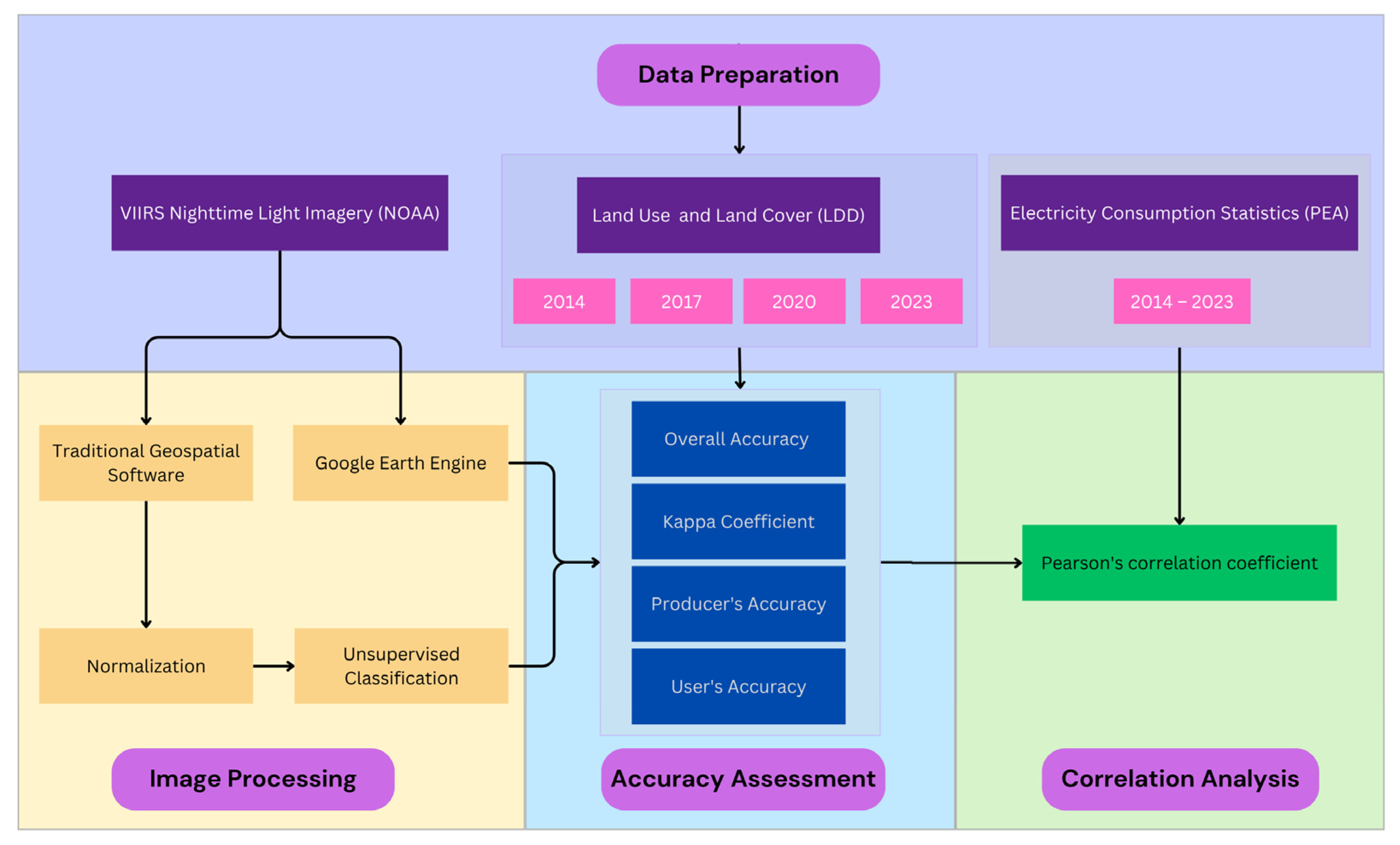


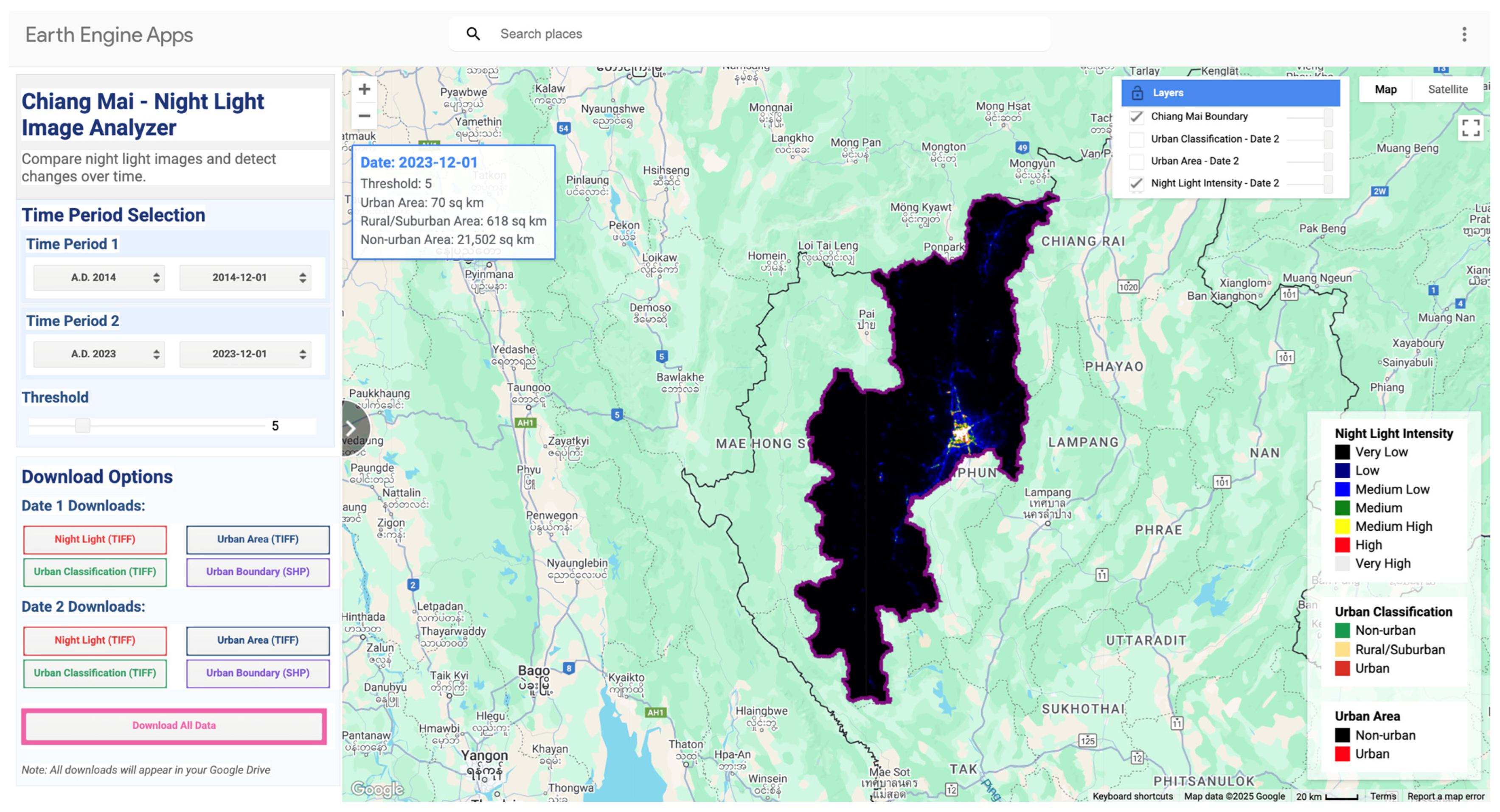
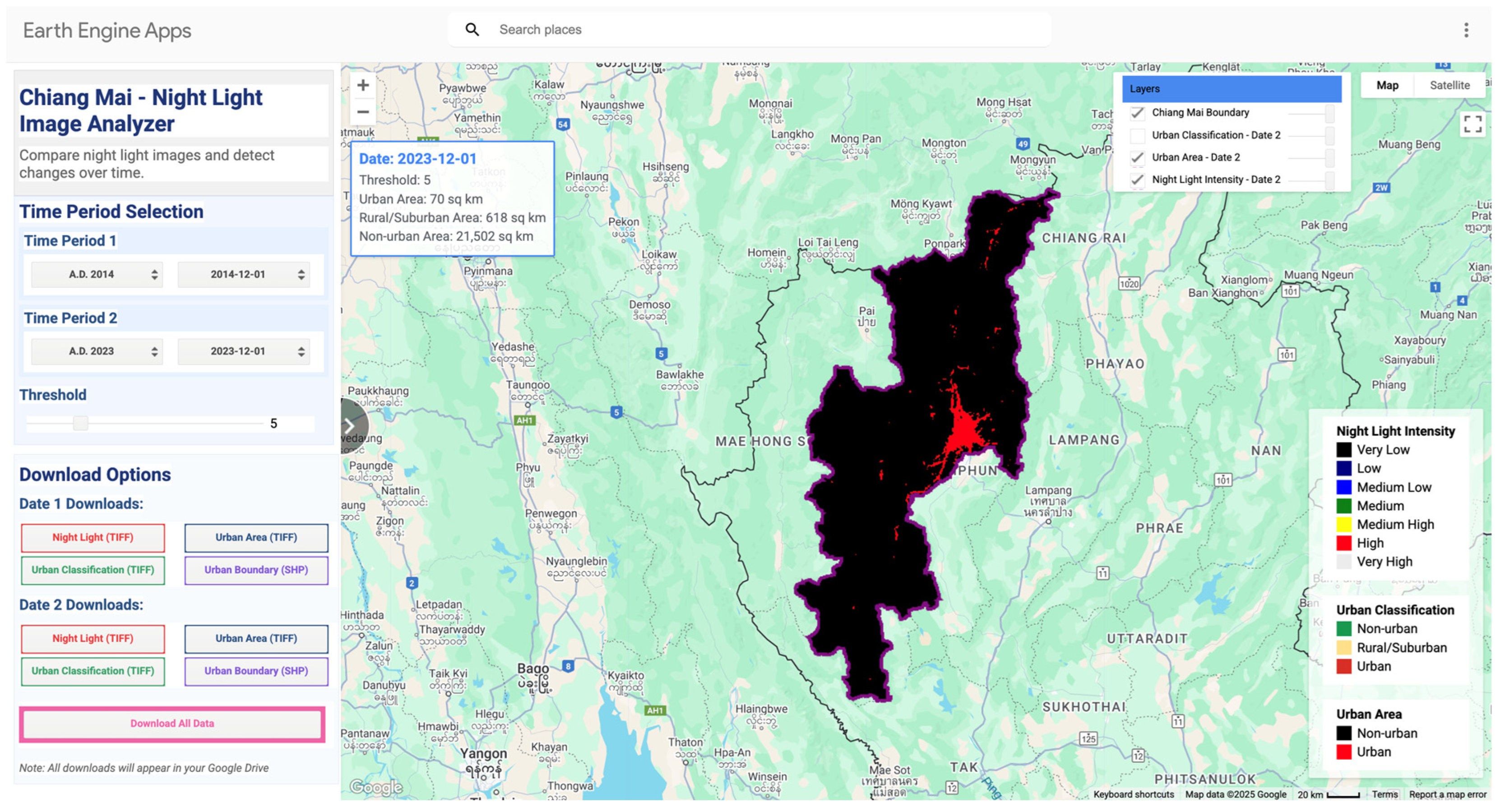
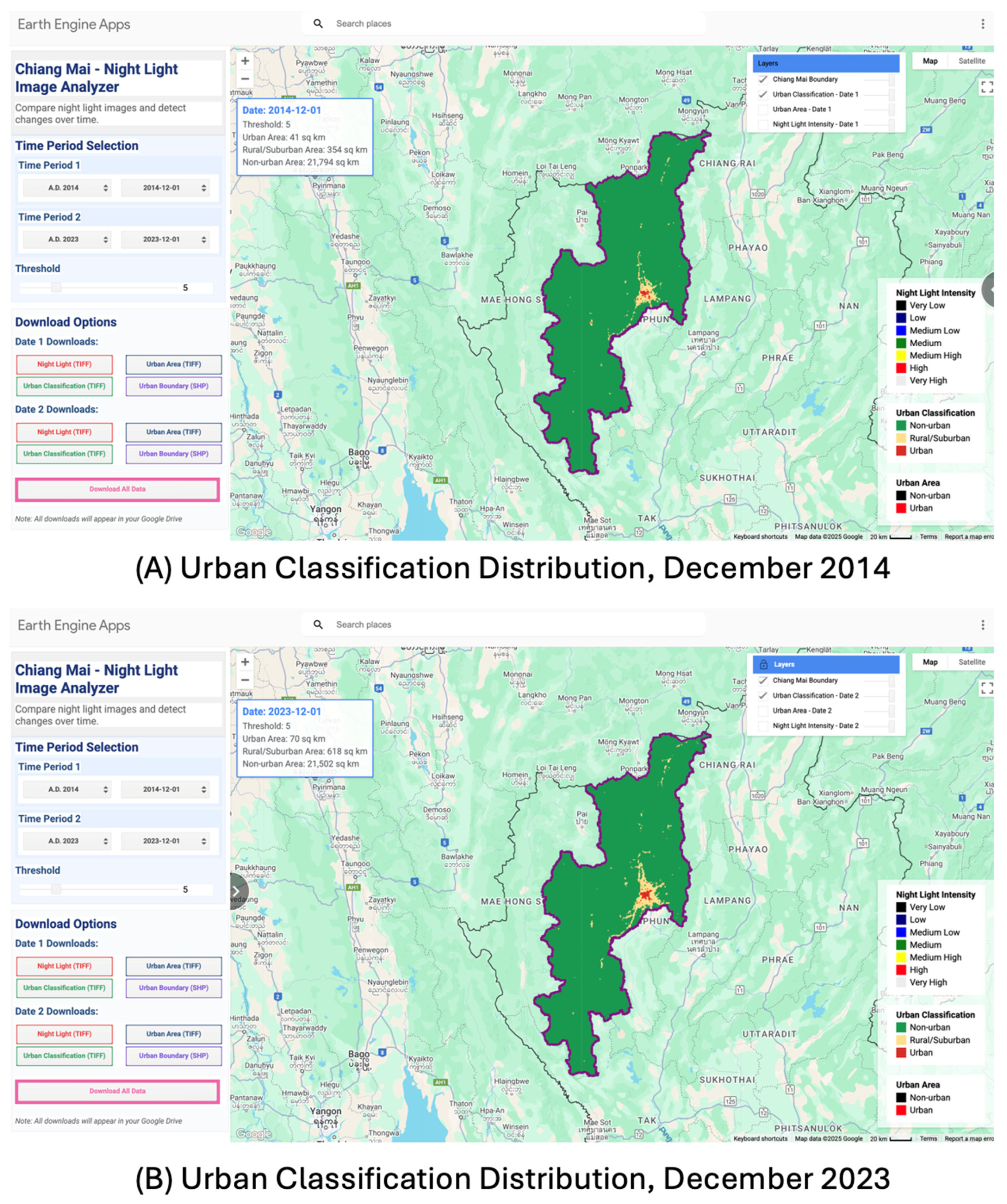
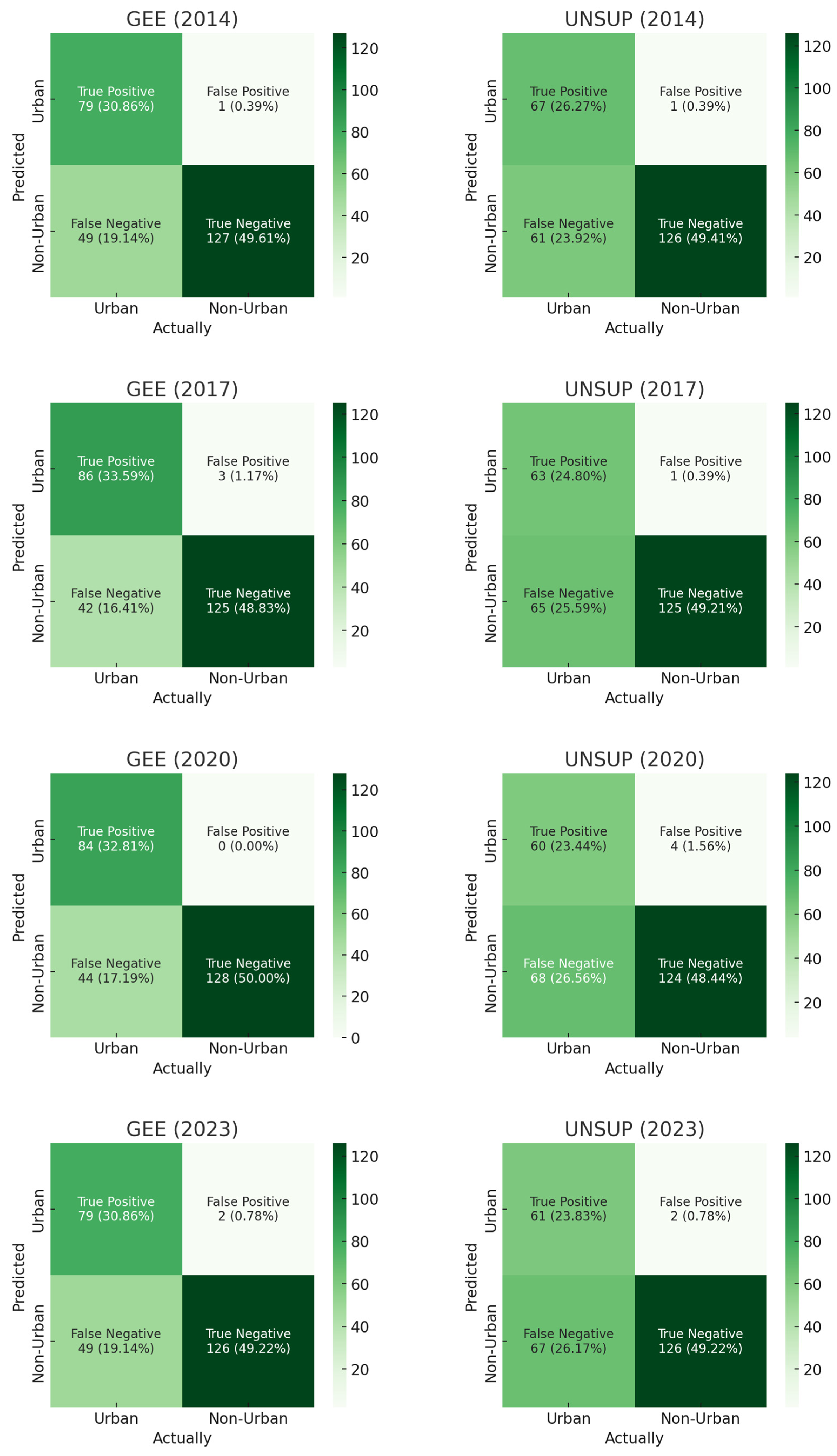
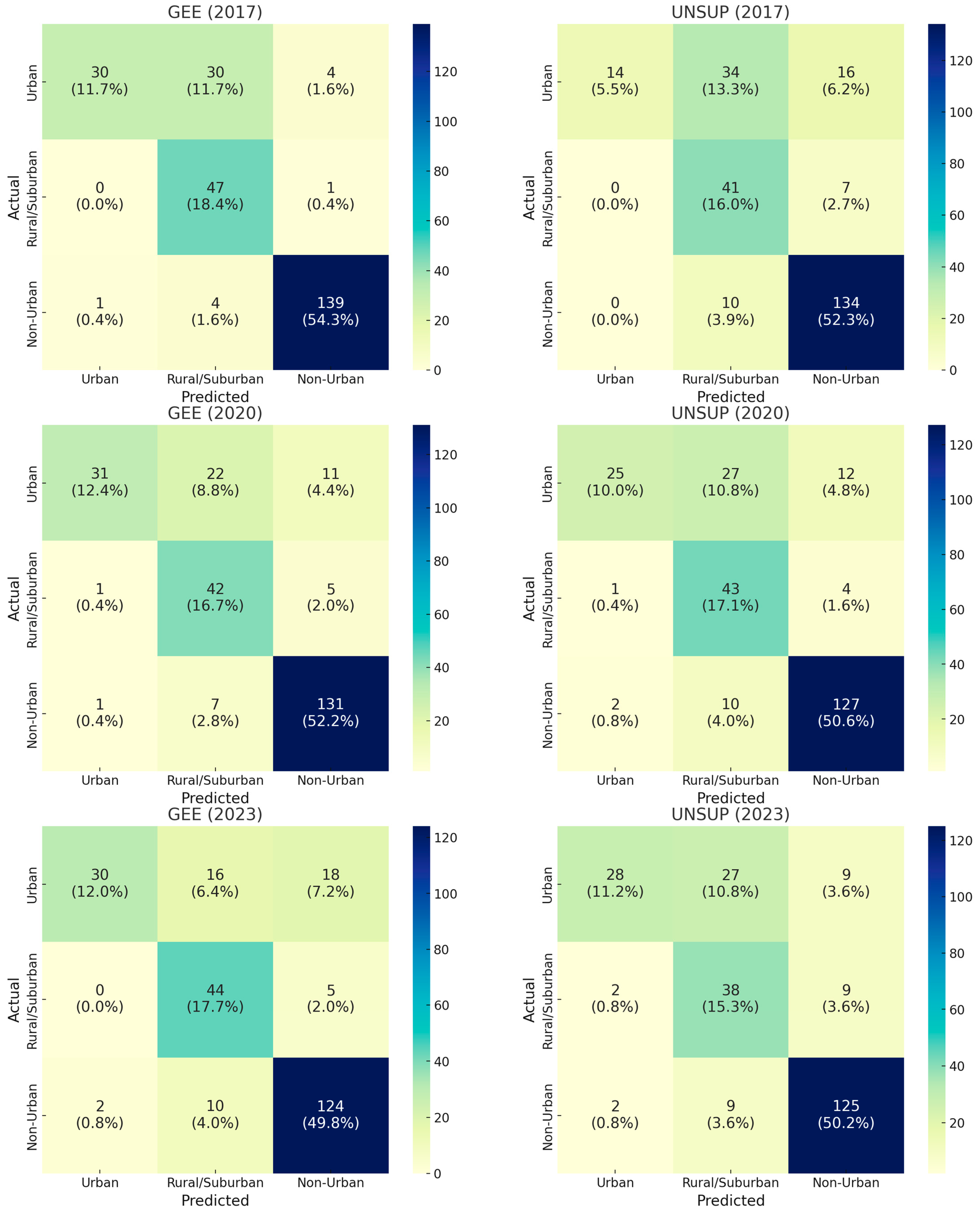

| Category | 2014 | 2017 | 2020 | 2023 |
|---|---|---|---|---|
| Residential (less than 150 kWh per month) | 238,864,320 | 239,521,266 | 269,068,999 | 225,400,548 |
| Residential (more than 150 kWh per month) | 754,948,956 | 917,712,361 | 1,264,496,114 | 1,561,746,937 |
| Small Business Activities | 471,201,360 | 555,381,551 | 587,471,680 | 632,866,146 |
| Medium Business Activities | 506,500,824 | 580,486,634 | 594,121,471 | 613,873,563 |
| Large Business Activities | 496,128,505 | 560,309,252 | 553,219,478 | 536,272,604 |
| Miscellaneous Activities | 218,773,212 | 250,816,651 | 171,936,294 | 183,683,592 |
| Non-profit Organizations | 11,611,040 | 13,885,983 | 12,070,316 | 12,942,110 |
| Agricultural Activities | 16,524,106 | 12,539,973 | 19,047,956 | 10,030,322 |
| Street Lighting | 36,818,207 | 44,744,909 | 37,335,825 | 33,056,341 |
| Total Electricity Produced and Consumed (kWh) | 2,751,370,530 | 3,175,398,580 | 3,508,768,133 | 3,809,872,163 |
| Year | GEE Area (Sq km) | UNSUP Area (Sq km) | ||||
|---|---|---|---|---|---|---|
| Urban | Rural | Non-Urban | Urban | Rural | Non-Urban | |
| 2014 | 41 | 354 | 21,795 | 42 | 515 | 21,633 |
| 2017 | 53 | 433 | 21,704 | 60 | 555 | 21,575 |
| 2020 | 65 | 492 | 21,633 | 65 | 759 | 21,366 |
| 2023 | 70 | 618 | 21,502 | 80 | 902 | 21,208 |
| Year | 2014 | 2017 | 2020 | 2023 | ||||
|---|---|---|---|---|---|---|---|---|
| Method | GEE | UNSUP | GEE | UNSUP | GEE | UNSUP | GEE | UNSUP |
| Overall Accuracy | 0.80 | 0.76 | 0.82 | 0.74 | 0.83 | 0.72 | 0.80 | 0.73 |
| Kappa Coefficient | 0.61 | 0.51 | 0.65 | 0.48 | 0.66 | 0.44 | 0.60 | 0.46 |
| Producer’s Accuracy | ||||||||
| Urban | 0.99 | 0.99 | 0.97 | 0.98 | 1.00 | 0.94 | 0.98 | 0.97 |
| Non-Urban | 0.72 | 0.67 | 0.75 | 0.66 | 0.74 | 0.65 | 0.72 | 0.65 |
| User’s Accuracy | ||||||||
| Urban | 0.62 | 0.52 | 0.67 | 0.49 | 0.66 | 0.47 | 0.62 | 0.48 |
| Non-Urban | 0.99 | 0.99 | 0.98 | 0.99 | 1.00 | 0.97 | 0.98 | 0.98 |
| Year | 2017 | 2020 | 2023 | |||
|---|---|---|---|---|---|---|
| Method | GEE | UNSUP | GEE | UNSUP | GEE | UNSUP |
| Overall Accuracy | 0.69 | 0.67 | 0.67 | 0.66 | 0.67 | 0.60 |
| Kappa Coefficient | 0.47 | 0.43 | 0.43 | 0.40 | 0.42 | 0.32 |
| Producer’s Accuracy | ||||||
| Urban | 0.76 | 0.82 | 0.79 | 0.86 | 0.85 | 0.51 |
| Rural/suburban | 0.38 | 0.46 | 0.39 | 0.36 | 0.47 | 0.10 |
| Non-Urban | 0.75 | 0.73 | 0.70 | 0.71 | 0.67 | 0.72 |
| User’s Accuracy | ||||||
| Urban | 0.47 | 0.22 | 0.48 | 0.39 | 0.47 | 0.44 |
| Rural/suburban | 0.30 | 0.48 | 0.23 | 0.28 | 0.27 | 0.05 |
| Non-Urban | 0.99 | 0.98 | 0.98 | 0.98 | 0.98 | 0.96 |
| Year | b (GEE Correct, UNSUP Incorrect) | c (GEE Incorrect, UNSUP Correct) | χ2 | p-Value | Significance |
|---|---|---|---|---|---|
| 2014 | 12 | 0 | 0.0 | 0.00049 | Significant (p < 0.05) |
| 2017 | 23 | 0 | 0.0 | 2.38 × 10−7 | Significant (p < 0.05) |
| 2020 | 24 | 0 | 0.0 | 1.19 × 10−7 | Significant (p < 0.05) |
| 2023 | 18 | 0 | 0.0 | 7.63 × 10−6 | Significant (p < 0.05) |
| Year | b (GEE Correct, UNSUP Incorrect) | c (GEE Incorrect, UNSUP Correct) | χ2 | p-Value | Significance |
|---|---|---|---|---|---|
| 2017 | 16 | 0 | 0.0 | 3.05 × 10−5 | Significant (p < 0.05) |
| 2020 | 6 | 0 | 0.0 | 0.03125 | Significant (p < 0.05) |
| 2023 | 2 | 0 | 0.0 | 0.5 | Not Significant |
Disclaimer/Publisher’s Note: The statements, opinions and data contained in all publications are solely those of the individual author(s) and contributor(s) and not of MDPI and/or the editor(s). MDPI and/or the editor(s) disclaim responsibility for any injury to people or property resulting from any ideas, methods, instructions or products referred to in the content. |
© 2025 by the authors. Published by MDPI on behalf of the International Society for Photogrammetry and Remote Sensing. Licensee MDPI, Basel, Switzerland. This article is an open access article distributed under the terms and conditions of the Creative Commons Attribution (CC BY) license (https://creativecommons.org/licenses/by/4.0/).
Share and Cite
Anucharn, T.; Hongpradit, P.; Iamchuen, N.; Puttinaovarat, S. Spatial Analysis of Urban Expansion and Energy Consumption Using Nighttime Light Data: A Comparative Study of Google Earth Engine and Traditional Methods for Improved Living Spaces. ISPRS Int. J. Geo-Inf. 2025, 14, 178. https://doi.org/10.3390/ijgi14040178
Anucharn T, Hongpradit P, Iamchuen N, Puttinaovarat S. Spatial Analysis of Urban Expansion and Energy Consumption Using Nighttime Light Data: A Comparative Study of Google Earth Engine and Traditional Methods for Improved Living Spaces. ISPRS International Journal of Geo-Information. 2025; 14(4):178. https://doi.org/10.3390/ijgi14040178
Chicago/Turabian StyleAnucharn, Thidapath, Phongsakorn Hongpradit, Niti Iamchuen, and Supattra Puttinaovarat. 2025. "Spatial Analysis of Urban Expansion and Energy Consumption Using Nighttime Light Data: A Comparative Study of Google Earth Engine and Traditional Methods for Improved Living Spaces" ISPRS International Journal of Geo-Information 14, no. 4: 178. https://doi.org/10.3390/ijgi14040178
APA StyleAnucharn, T., Hongpradit, P., Iamchuen, N., & Puttinaovarat, S. (2025). Spatial Analysis of Urban Expansion and Energy Consumption Using Nighttime Light Data: A Comparative Study of Google Earth Engine and Traditional Methods for Improved Living Spaces. ISPRS International Journal of Geo-Information, 14(4), 178. https://doi.org/10.3390/ijgi14040178







